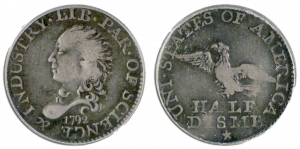A Small Coin with Huge Historical Significance
Posted onThe United States of America was still in its infancy in the early 1790’s. The Founding Fathers signed the Constitution just a few years before in 1787 and many landmark events that shaped the country we are today occurred in the years that followed.

Up until this time, American colonists were forced to use European coins for everyday purchases. The Spanish dollar was a popular method of transactions at that time.
The nation faced a shortage of small change and it was clear that America needed its own system of currency. America needed its own coinage, especially small change, and they needed it fast.
The first Secretary of the Treasury – Alexander Hamilton – began outlining a system for America’s coins in 1790.
First coin struck by U.S. government
Out of that plan, the Half Disme, or half a dime, was the first coin ever struck by the authority of Congress under the April 1792 Mint Act.
The story of how the Half Disme got its name traces back to both Hamilton and Thomas Jefferson. They advocated the use of the decimal system as the standard in U.S. money.
Jefferson explained: “The most easy ratio of multiplication and division is that of ten.”
Just over 100 years earlier, a French mathematician invented the decimal system in a book called “La Disme” or “The Tenth.” The 10-cent piece represented 1/10 of a dollar and was thus named the disme. Most Americans pronounced the French word “dime” and the “s” was later dropped.
Silver coins signaled strength to the world
In the 18th century, the minting of silver coins was considered an indicator of a country’s economic strength. Some historians believe this was behind President Washington’s push to create the Half Dismes as quickly as possible.
As the Half Disme was the smallest silver coin, it enabled the largest minting from the limited supply of available silver. In fact, President Washington brought $100 worth of his own bullion and coin to the Mint to use in the first strike.
The old name, for the Half Dismes, sometimes seen in 19th century writings, calls the first coin the “Washington Half Dismes.”
The Philadelphia Mint hadn’t even opened its doors yet
In the summer of 1792, the Philadelphia Mint, located on Seventh Street in downtown Philadelphia near the Arch was still under construction.
Impatient to get U.S. silver coins minted, the Half Dismes were struck in the cellar of a building owned by John Harper at 6th and Cherry Streets in Philadelphia.
A total of 1,500 silver Half Dismes were struck in July 1792.
Thomas Jefferson, then Secretary of State noted the event on July 13, 1792, in his household account book: “rec’d from the mint 1,500 half dimes of the new coinage.”
The Half Disme was considered a pattern coin, intended as a test to show the size, form and design of the future coins. Yet, many 1792 Half Dismes circulated.
Construction on the Philadelphia mint building was finalized soon after in September.
The coin description
Many in the House of Representatives advocated for a representation of the President’s head on the obverse of the coins. Washington nixed that idea fast.
Engraver Robert Birch designed the early 1792 Half Dismes. The obverse features the head of Liberty facing left, with the date 1792 below. The reverse portrays an eagle flying left with the words HALF DISME below.
History in your hands
While today’s dime may not resemble the Half Disme, it is a direct descendent of this landmark coin that was minted in 1792. It’s a small coin with huge historical significance.
In 2018, the finest known 1792 Half Disme, graded MS68 sold for $1,985,000. That coin was owned by the first United States Mint Director David Rittenhouse. Lesser condition Half Dismes can sell for much less.







